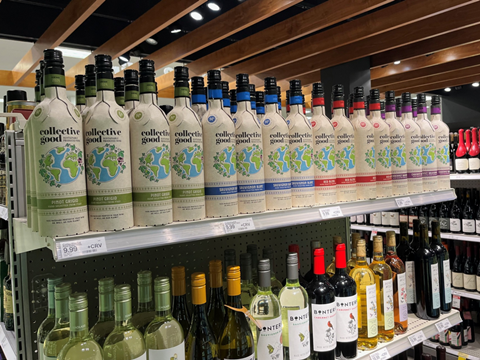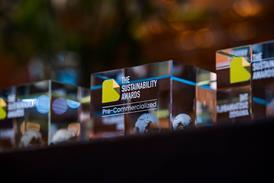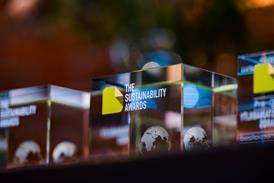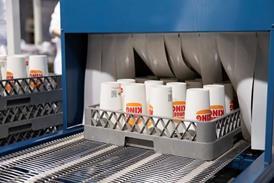
Frugalpac’s paper wine bottles, made from 94% recycled paperboard and a certified recyclable plastic pouch, have hit the shelves at Target in a move anticipated to save almost 87.8 tons of CO2e.
Each Frugal Bottle constitutes a recycled, paper-based body and a food-grade pouch to hold the wine; the latter made from a polyethylene metallized polyester laminate – the same material used in bag-in-box wines, Frugalpac explains – and is certified as recyclable.
Altogether, the bottle is said to use 77% less plastic than a plastic bottle, utilizing only 15g compared to a 64g bottle made from 100% recycled plastic. Reportedly manufactured without chemicals, the paper and plastic components can be separated and placed in their respective recycling bins at end-of-life.
The Frugal Bottle weighs 83g and is therefore believed to be up to five times lighter than a standard glass bottle. As such, it is said to be lighter to transport and easier for consumers to carry.
According to an independent Life Cycle Analysis from Intertek, a standard wine glass bottle’s carbon footprint is reported at 440g CO2e, while a Frugal Bottle’s is placed at 91.9g CO2e – making the paper-based alternative 84% less carbon-intensive, according to Frugalpac.
Its carbon footprint is over a third lower than a bottle made from 100% recycled plastic, the LCA posits, while its water footprint is thought to be at least four times lower than glass.
Frugalpac continues to suggest that manufacturers can produce Frugal Bottles ‘in the heart’ of their bottling facilities. They are believed to be more cost-effective and less carbon-intensive to transport than glass bottles.
Since their outer packaging is made entirely from recycled paperboard, the bottles are also compatible with 360-degree branding, which apparently enhances their shelf appeal.
Target claims to be the first major US retailer to commission a range of wines in paper bottles in all its stores, having ordered 256,000 Frugal Bottles filled with the Collective Good wine range; this is anticipated to offset the equivalent amount of CO2e as 99,058 pounds of burned coal and 206 barrels of consumed oil, as calculated by the US Environmental Protection Agency Greenhouse Gas Equivalencies Calculator.
“The U.S. has been a real trailblazer in our paper bottle revolution,” said Frugalpac CEO Malcolm Waugh. “Their wines and spirits brands were amongst the first to move to the Frugal Bottle and its clear there’s an increasing market for people who want to drink more sustainably.
“We’re proud to see Target making this commitment to stocking the Collective Good in all their retail outlets. It’s a big endorsement for sustainable low carbon packaging that can deliver great taste but less waste.”
The paper bottles are filled by Monterey Wine Company, which has now acquired a Frugal Bottle Machine to produce more bottles on-site. Reportedly, the machine is capable of producing over 2.5 million Frugal Bottles every year.
“At Monterey Wine Company pioneering innovation embracing new technologies and driving much-needed sustainability and efficiency in the wine packaging industry is written into our DNA,” said general manager Shannon Valladarez.
“As the first U.S. producer of the Frugal Bottle, we are proud to partner with Target to bring The Collective Good wines to nearly 1,200 stores in the revolutionary paper Frugal Bottle.
“This launch is a testament to the collaboration of committed corporations to reduce the industry’s carbon footprint while delivering quality wines in cutting-edge, eco-friendly packaging.”
A video of the production process for the paper Collective Good bottles is available to watch.
Another predominantly paper-based bottle was recently unveiled by Zipform Packaging. Manufactured from 95% wood-based fibre and over 50% post-consumer recycled content, it utilizes a moisture- and oxygen-resistant barrier layer instead of a conventional plastic liner – a move hoped to improve its overall recyclability.
Earlier in the year, NBCo pitched its ‘disappearing’ fibre-based bottle – described as up to 99% recyclable and biodegradable in the natural environment – at the World Economic Forum Annual Meeting in Davos. It is made using ‘rapidly renewable’ plant materials such as bamboo, agricultural waste like bagasse, and local, indigenous fibre mixes, coated in natural polymers, and is designed to conserve natural resources while minimizing strain on waste systems.
If you liked this story, you might also enjoy:
Reuse vs. single use – which is better for the environment?
Sustainable Innovation Report 2025: Current trends and future priorities
What can the world learn from South Korea’s world-leading performance in plastics circularity?












No comments yet